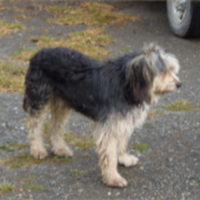 |
Ovejero Magallánico |
|
He is not recognized by the F.C.I. |
Origin |
Chile | |
Translation |
Francis Vandersteen |
| The Ovejero Magallánico is a breed of dog native to Chilean Patagonia. It was developed to work with sheep. Today, the Kennel Club is working to achieve international recognition for the breed. The history of the Ovejero Magallánico dates back to the late 19th century, when groups of people involved in sheep handling arrived in the region and needed the help and support of specialized dogs. Over the years, these imported dogs, which were probably not of the same type, were crossed with a purely utilitarian criterion, namely specimens capable of developing pasture work, resistant to the extreme climatic conditions of Patagonia, were selected from Chile and Argentina. It's possible that, among the dogs that contributed their genetic heritage to give birth to the Ovejero Magallánico, in addition to sheepdogs, there was the yagán or fuegian dog, most probably descended from the aguará guazú, a species of South American fox, an ancestral breed of dog that existed before colonization and accompanied the selknam and yaganes. It became extinct at the beginning of the 20th century. An innate instinct for grazing sheep, intelligence, a submissive and loyal character, and above all resistance to extreme cold, snow and long distances, are among the Magellanic Sheepdog's distinctive features. Among other things, he is one of the few sheepdogs in the world capable of keeping pace with horse riders, covering more than 30 km. every day, and looking after a thousand sheep with five companions. In the middle of the southern tundra, it eats every three days and barely drinks water when it's working, without ever leaving the flock, which is not the case with other breeds introduced in recent years, such as the Scottish Border Collie or the Australian Kelpie. Little known in Chile, the Magellanic Sheepdog has been the main working tool of Patagonian cattle breeders for the past 100 years, immortalized in the Shepherd Monument in Punta Arenas. Medium-sized, around 50 centimetres, with long hair, a square muzzle and pointed ears, it has a thick coat capable of repelling snow. Although its origins can be traced back to European grazing dogs that arrived with the first herds in the region, it is their power of adaptation to an extreme environment that has generated a new phenotype that represents a national heritage for the Kennel Club. The risk of losing the genetics of this Creole breed is latent, due to uncontrolled crossing. To certify it, experts censure them to record their lineage and phenotype on the basis of DNA and other measurements, and thus present the breed's "standard", i.e. the description of their physical traits, character and functionality. If recognized, this would be the second nationally certified breed. The Chilean Fox Terrier already has this status and is awaiting international certification. According to Eduardo Montoya, of the Kennel Club of Chile's Emerging Breeds Commission, genetic and microchip identification of at least six pure families and basic statistics collected in the field are the requirements of the "Fédération Cynologique Internationale (FCI) to certify this an endemic breed, typical of Chile and, in a second phase, an internationally renowned race to participate in shows". For Werner Kirschbaum, former FCI Argentine judge for 50 years, breeder and specialist in 20 breeds, "the Magellanic Sheep is a great dog, made by the environment. For what it's worth, it would be a shame for Chile to lose it." |






 English (United Kingdom)
English (United Kingdom)